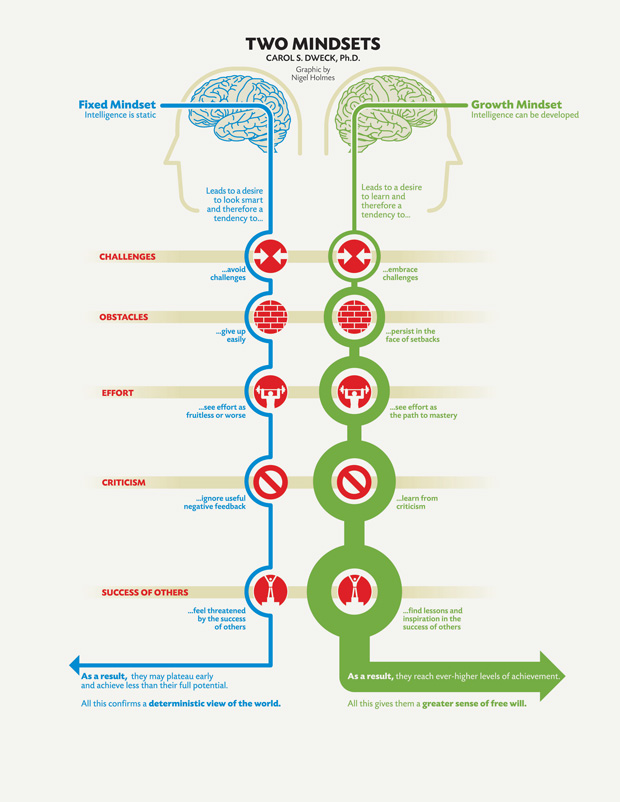You might have heard about something called a growth mindset and how it can positively impact an organisation.
But what is it and how do you have it?
The answer to that is both deep and logical. And to understand it, we must step back and understand its origins first.
The theory and philosophy of a Growth Mindset was first explored by American psychology professor from Sandford, Carol Dweck and her colleagues.
In her words, her work, ‘bridges developmental psychology, social psychology, and personality psychology, and examples the self-conceptions or mindsets people use to structure the self and guide their behaviour.’
In a nutshell, her work seeks to understand why some people succeed and others don’t, and the mindsets involved that influence these outcomes. Her studies were published in Mindset: The New Psychology of Success in 2007.
How organisations treat their staff, what the individuals think about themselves, the work they do and more, contribute to happiness and satisfaction at work.
This is because the environment and how one perceives their place in that environment has an impact on the way they think and act.
Consider how we are molded by our experiences and our environment, be it at home, school or work. Dweck’s studies seek to understand how those factors affect us, in the way we think and our ability to perform at work, home or both.
Dweck’s research focuses on these aspects to find ways to resolve or help the individual move into a more positive mindset, especially at work, to become a better employee.
Her studies, however, do not wholly place the responsibility of such a monumental switch on the individual but on the organisation as well.
It requires consistent effort from both parties to cultivate, encourage and instill a growth mindset.
Decades ago, and even as recently as pre-COVID, issues like mental health and work stress were either ignored or not dealt with properly. Most would be familiar with terms like, ‘deal with it’ or having it heavily implied that mental health issues are just an excuse for their underperformance.
However, the pandemic has ironically contributed to a sharp rise of interest in mental health with companies actively making an effort to ensure that people-first also includes their employees.
So, what has this to do with growth mindset?
Simply, Dweck’s studies showed that companies with employees who exhibit a growth mindset are not just happy but more creatively driven to innovate in order to help the company succeed.
Those with a fixed mindset do not.
Let’s dive a bit deeper.
Fixed vs Growth
A growth mindset essentially means viewing challenges not as stumbling blocks, but as a means to improve yourself to overcome those challenges and obstacles. It is about developing resilience.
A fixed mindset typically views a challenge as immutable and an absolute deterrence to one’s ability to move forward.
Simply, when viewing a challenge, someone with a fixed mindset might say something like:
“It’s too hard, I can’t do it. I give up”
While a person with a growth mindset would approach a similar situation with this attitude:
“This is challenging but I can do it. What skills do I need to learn to overcome this?”
One is easy and the other is hard. Which is which, depends on the individual.
Having a growth mindset is a reframing of how one thinks and approaches situations in life – whether they freeze and give in or recognize that while it may be uncomfortable and difficult, it’s not impossible.
With time and some effort, they are confident in overcoming this challenge.
We’ve all encountered people who buckle at the sight of the slightest adversity; unable and unwilling to try anything to move forward.
On the other hand, we’ve experienced people who do not appear phased when facing those same obstacles, and will instead keep trying until they achieve a certain result.
Be supportive of your employees in their quest for growth
A growth mindset is part and parcel of agile transformation. And agile transformation encourages companies to put emphasis on people and culture. This translates to enabling transparency and to encourage collaboration among team members.
This will enable people to learn from one other and encourage each other’s efforts in pursuing growth opportunities beyond their comfort zones.
Also remember to celebrate the right successes along the way (so you don’t trivialise it)—whether it was an individual who took a leap of faith or a whole team that tried something new and learned from the experience.
Celebrating these small but key wins will keep everyone motivated to continue growing together as an organization.
In business, the winner is clear.
Companies want tenacious, determined and driven people. People with a growth mindset are always thinking about how to solve a challenge and what they need to do in order to achieve a goal. They’re not hamstrung by the thought of failure, and are instead emboldened by it.
Some people might consider such attributes as an attitude or something one is born with. This is false.
Dweck postulates that our personal view of ourselves determines everything.
If we believe that our expertise, qualities, knowledge, abilities and more are unchangeable, then intrinsically, we will want to prove that justification repeatedly to ourselves instead of learning and growing from mistakes. It’s like a self-fulfilling prophecy.
This type of mindset can also be studied in individuals who suffer from mental health issues, like depression, anxiety, low self-esteem and more.
It’s a sign of how the individual perceives themselves in society and against their peers but of course, influenced by internal negative self-perceptions as a result of upbringing and other factors.
In the below diagram from Carol Dweck’s blog, she illustrates the contrasting differences between the two mindsets.
A fixed mindset when left alone is damaging.
It breeds negativity and a self-defeatist attitude. These can easily overwhelm and overtake a person’s ability to positively or even objectively perceive themselves.
This typically results in that individual’s confidence and performance at work – even in their personal life – to decline significantly.
A study Dweck did, working adults showed that those with a fixed mindset were afraid of trying new things and were less engaged. This is because they felt unvalued by the company.
The fear of failure was so strong, it immobilised them leading to frustrations, low performance and a host of other negative results.
In agile, learning and growing from failure is an important part of the process.
Failure can be celebrated as a milestone. A growth mindset views failure merely as a springboard to success, not as a detriment to progress.
This doesn’t mean that people with a growth mindset are going to commit themselves to achieving success even when it stops making sense.
In product terms, success might mean pivoting based on research and capability rather than forcing it through rejection.
That’s a type of growth mindset that is equally important; to know when you need to change tactics in order to achieve goals instead of throwing your hands in the air and admitting defeat. A growth mindset allows for adaptation.
To do that, one must be undaunted in the face of failure. One must be honest with themselves and know that it’s okay to try a different strategy and that failure is part of the process.
The issue, however, is that our default experiences at work, school and even at home is to fear failure.
In the next part, we will discuss more about what this means and what one needs to do to circumvent this traditional mindset.
Click for Part Two.
Have a question?
If you want to learn more about growth mindset or are ready to take the plunge with help from an experienced consultant, reach out to us.






